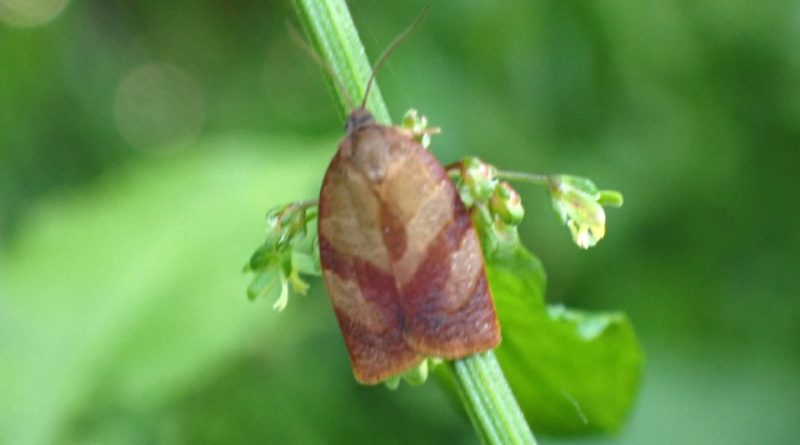Cacoecimorpha pronubana
Cacoecimorpha pronubana
The Carnation Tortrix (Cacoecimorpha pronubana Hübner, 1799) is an insect belonging to the Tortricidae family.
Systematics –
From a systematic point of view it belongs to:
Eukaryota domain,
Kingdom Animalia,
Subkingdom Eumetazoa,
Superphylum Protostomia,
Phylum Arthropoda,
Subphylum Tracheata,
Superclass Hexapoda,
Class Insecta,
Subclass Pterygota,
Endopterygota cohort,
Superorder Oligoneoptera,
Panorpoid section,
Order Lepidoptera,
Glossata suborder,
Infraorder Heteroneura,
Ditrysia division,
Superfamily Tortricoidea,
Family Tortricidae,
Subfamily Tortricinae,
Archipini Tribe,
Genus Cacoecimorpha,
Species C. pronubana.
The term is basionym:
– Tortrix pronubana Hübner, 1799.
The terms are synonyms:
– Cacoecia ambustana Frölich, 1830;
– Cacoecia hermineana Duponchel, 1834;
– Cacoecia insolatana Lucas, 1848;
– Cacoecimorpha ambustana (Frölich, 1830);
– Cacoecimorpha hermineana (Duponchel, 1835);
– Cacoecimorpha perochreana (Herrich-Schäffer, 1856);
– Tortrix hermineana Duponchel, 1834;
– Tortrix perochreana Herrich-Schäffer, 1856;
– Tortrix pronubana Hübner, 1799.
Within this species the following subspecies are recognised:
– Cacoecimorpha pronubana subsp. obsoletana (Strand, 1901);
– Cacoecimorpha pronubana subsp. pronubana.
Geographic Distribution and Habitat –
The Cacoecimorpha pronubana is a moth native to the western Palaearctic. The species is widespread in Europe. In the south, the presence extends to the tropical zones of Africa and, in the east, up to the Middle East. In England the first records date back to 1905. The species was introduced in the Nearctic (North America). There are matches in the US states of Washington, Illinois and Florida.
This insect can attack, in particular, plants of Arbutus unedo, Asphodelus, Dianthus, Euphorbia amygdaloides, Fragaria, Fuchsia, Hedera helix, Hippophae rhamnoides, Laurus nobilis, Ligustrum, Pelargonium, Robinia, Rosa, Rosmarinus, Thuja occidentalis, Viburnum tinus, Vitis vinifera and other plants.
Morphology –
The Cacoecimorpha pronubana is a medium-sized butterfly, with a 14-20 mm wingspan.
The male has ocher forewings with a greyish-brown transverse band and margins. The female is paler with a more uniform livery.
The larvae are greenish-yellow or dark green, depending on age, and reach a length of 22-24 mm.
The chrysalis, which measures 8-12 mm, is initially brown, then gradually becomes darker, almost blackish. In some individuals, however, the lighter coloration remains.
Attitude and biological cycle –
The Cacoecimorpha pronubana is a moth that winters in the stage of mature larva or chrysalis on the affected plants. The adults usually flicker in April.
After mating, they ovipose in plates on the leaves, originating a number of generations often overlapping each other and in a variable number depending on the environmental conditions in which the carnation is grown.
In central Europe, it normally produces two generations a year; more generations are possible, as mentioned, in the southern regions and in greenhouses.
Its biological cycle is determined by its polyphagia.
The caterpillars can be found on their main host plant, the field carnation (Dianthus caryophyllus), as well as on numerous other plants, especially ornamental plants such as roses or chrysanthemums.
The first larval stage is that of leaf miner. The following larval stages feed on the surface of the leaves, causing large leaf erosions and a decrease in the photosynthetic surface area.
The more mature caterpillars feed on both young leaves and shoots. This often leads to deformation of the flowers.
Ecological Role –
Cacoecimorpha pronubana is an insect visible almost all year round, with the polyphagous larva which, under certain conditions, can cause serious problems for crops.
The insect first digs small mines on the leaves; later real erosions appear on the shoots and leaves. Affected shoots curve characteristically; finally, external erosions of the flower buds appear which, more rarely, are emptied.
In greenhouses, the larvae can cause considerable damage if they occur in large numbers.
The damage is, therefore, caused by the larval states.
The fight against these two insects has so far followed the criteria of guided and integrated fight.
Sex pheromones have been synthesized for this species, for which it is possible to follow the trend of the flights and the size of the populations by installing monitoring sex traps. With monitoring it is possible to identify the periods of maximum flight and therefore of maximum oviposition in order to intervene more promptly on the larvae.
Furthermore, some chitin-inhibitory growth and development regulators have also demonstrated good activity, especially if used in the initial stages of embryonic development (egg) and on the first larval stages. In protected crops, the technique of sexual confusion (disorientation) is being tested through the application of filiform dispensers or evaporation diffusers, from which the pheromone evaporates in high concentration.
In recent times, interventions with Bacillus thuringiensis ssp have been experimented. kurstaki, combined with some stressors, as adjuvants of the action of the bacterium itself.
For this Tortricide, given its dangerousness, mandatory intervention or quarantine decrees have been issued at the level of various countries. In Italy the matter is regulated by the D.M. 30/11/52 and 27/8/73, in which the compulsory fight is foreseen.
Guido Bissanti
Sources
– Wikipedia, the free encyclopedia.
– GBIF, the Global Biodiversity Information Facility.
– Russo G., 1976. Agricultural entomology. Special Part. Liguori Publisher, Naples.
– Pollini A., 2002. Handbook of applied entomology. Edagricole, Bologna.
– Tremblay E., 1997. Applied entomology. Liguori Publisher, Naples.
Photo source:
– https://inaturalist-open-data.s3.amazonaws.com/photos/283673703/original.jpeg

